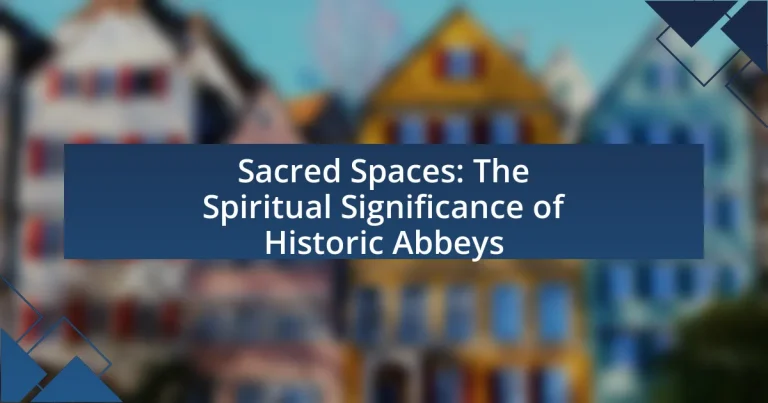Sacred spaces, particularly historic abbeys, hold significant spiritual importance as sites for worship, meditation, and reflection. These locations foster a connection to the divine and enhance personal spiritual experiences through their architectural features and tranquil settings. The article explores how abbeys qualify as sacred spaces, their role in preserving religious traditions, and their influence on local communities and modern spirituality. It also discusses the spiritual practices associated with abbeys, the benefits of visiting these sites, and how individuals can incorporate the essence of abbeys into their personal spiritual lives.

What are Sacred Spaces and Their Importance in Spirituality?
Sacred spaces are locations that are imbued with spiritual significance, often serving as sites for worship, meditation, and reflection. These spaces, such as historic abbeys, are important in spirituality because they provide a physical environment that fosters a connection to the divine, facilitates communal worship, and enhances personal spiritual experiences. Research indicates that environments perceived as sacred can evoke feelings of awe and reverence, which are essential for spiritual growth and well-being. For example, studies have shown that individuals who engage in spiritual practices within sacred spaces report higher levels of life satisfaction and emotional health.
How do historic abbeys qualify as sacred spaces?
Historic abbeys qualify as sacred spaces due to their historical role as centers of monastic life, worship, and community. These structures often embody architectural and artistic elements that reflect spiritual significance, such as altars, chapels, and cloisters designed for contemplation and prayer. For instance, the Abbey of Cluny in France, founded in 910, became a model for monastic reform and influenced the development of sacred architecture across Europe. Additionally, abbeys frequently house relics and artifacts that are venerated, further enhancing their status as places of spiritual importance. The continuous use of these sites for religious ceremonies and pilgrimages reinforces their identity as sacred spaces within the cultural and historical context of Christianity.
What architectural features contribute to the sacredness of abbeys?
Architectural features that contribute to the sacredness of abbeys include their layout, use of light, and incorporation of religious symbols. The layout often follows a cruciform design, symbolizing the Christian faith and creating a sense of order and purpose. The strategic placement of windows allows natural light to illuminate the interior, enhancing the spiritual atmosphere and creating a connection between the divine and the earthly. Additionally, the presence of altars, chapels, and intricate carvings of biblical scenes serves to reinforce the religious significance of the space, inviting contemplation and worship. These elements collectively establish abbeys as sacred spaces, deeply rooted in their architectural design and spiritual intent.
How do the locations of abbeys enhance their spiritual significance?
The locations of abbeys enhance their spiritual significance by situating them in remote, tranquil environments that foster contemplation and connection with the divine. These settings often include natural landscapes, such as mountains or forests, which historically have been viewed as sacred spaces, promoting a sense of peace and reflection. For example, many abbeys were built in secluded areas to allow monks and nuns to escape worldly distractions, thereby deepening their spiritual practices. The architectural design of abbeys often harmonizes with their surroundings, further emphasizing their role as places of worship and meditation. This integration of location and purpose reinforces the spiritual experience for visitors and practitioners alike.
Why are historic abbeys considered vital to cultural heritage?
Historic abbeys are considered vital to cultural heritage because they embody significant historical, architectural, and spiritual values. These structures often represent the artistic and cultural achievements of their time, showcasing unique architectural styles and craftsmanship that reflect the societal values and religious practices of past eras. For instance, many abbeys were centers of learning and preservation of knowledge during the Middle Ages, contributing to the cultural development of Europe. Additionally, abbeys often serve as pilgrimage sites, fostering community and spiritual connections that have persisted through generations, thus reinforcing their importance in the cultural landscape.
What role do abbeys play in preserving religious traditions?
Abbeys play a crucial role in preserving religious traditions by serving as centers for monastic life, worship, and education. These institutions maintain liturgical practices, rituals, and theological teachings that have been passed down through generations. For example, many abbeys continue to celebrate the Divine Office, a structured form of prayer that dates back to early Christianity, thereby ensuring the continuity of these spiritual practices. Additionally, abbeys often house libraries and archives that preserve ancient texts and manuscripts, which are vital for understanding the historical context of religious traditions. This commitment to safeguarding both the practices and the intellectual heritage of faith communities underscores the significance of abbeys in the ongoing transmission of religious traditions.
How do abbeys influence local communities and their identities?
Abbeys influence local communities and their identities by serving as centers of spiritual, cultural, and social life. These religious institutions often provide a sense of belonging and continuity, shaping local traditions and practices. For example, many abbeys host festivals, rituals, and community events that reinforce local identity and heritage. Historical records indicate that abbeys have been pivotal in education and charity, contributing to the social fabric of their regions. Additionally, the architectural presence of abbeys often becomes a symbol of local pride, attracting tourism and fostering economic development, which further embeds them into the community’s identity.

What Spiritual Practices are Associated with Historic Abbeys?
Historic abbeys are associated with various spiritual practices, including monastic prayer, meditation, communal worship, and the observance of liturgical rituals. Monastic prayer often involves the Liturgy of the Hours, which consists of specific prayers and psalms recited at designated times throughout the day, fostering a rhythm of spiritual life. Meditation practices in abbeys may include contemplative silence and reflection, allowing individuals to deepen their connection with the divine. Communal worship is central to abbey life, where monks or nuns gather for Mass and other sacraments, reinforcing community bonds and shared faith. Additionally, the observance of liturgical rituals, such as feasts and seasons of the church calendar, provides structure to the spiritual life within these sacred spaces. These practices are rooted in the historical traditions of monasticism, which date back to the early centuries of Christianity, emphasizing the importance of prayer and community in the pursuit of spiritual growth.
How do monastic practices shape the spiritual atmosphere of abbeys?
Monastic practices shape the spiritual atmosphere of abbeys by fostering a disciplined environment centered on prayer, meditation, and communal living. These practices create a sense of tranquility and focus, essential for spiritual growth. For instance, the daily rhythm of liturgical prayers and the observance of silence cultivate an atmosphere conducive to reflection and connection with the divine. Historical evidence shows that the Rule of St. Benedict, established in the 6th century, emphasizes the importance of communal worship and personal contemplation, which has been foundational in shaping the spiritual identity of many abbeys. This structured approach not only enhances individual spirituality but also strengthens the communal bonds among monks, contributing to a collective spiritual energy that permeates the abbey.
What types of rituals are commonly performed in abbeys?
Common rituals performed in abbeys include daily prayers, communal worship, the Liturgy of the Hours, and special ceremonies such as ordinations and feast day celebrations. Daily prayers, often structured around specific times, allow monks or nuns to engage in spiritual reflection and connection with the divine. The Liturgy of the Hours, a series of prayers recited at various times throughout the day, is a central practice in monastic life, emphasizing the rhythm of prayer in accordance with the liturgical calendar. Special ceremonies, such as ordinations, mark significant milestones in the lives of the clergy and the community, while feast day celebrations commemorate important events in the Christian tradition, reinforcing the abbey’s role as a spiritual center.
How do these rituals connect visitors to the divine?
Rituals connect visitors to the divine by facilitating a direct experience of spirituality and fostering a sense of community. These practices, such as prayer, meditation, and communal worship, create an environment where individuals can transcend their everyday lives and engage with a higher power. Historical evidence shows that rituals in sacred spaces, like those in historic abbeys, have been designed to evoke feelings of awe and reverence, enhancing the spiritual experience. For instance, the use of sacred music and architectural elements in abbeys has been documented to elevate the emotional state of participants, allowing them to feel a deeper connection to the divine.
What role do abbeys play in personal spiritual journeys?
Abbeys serve as significant spaces for personal spiritual journeys by providing environments conducive to reflection, meditation, and community. These historic sites often embody tranquility and a sense of the sacred, allowing individuals to disconnect from daily distractions and engage in deeper self-exploration. The architectural design and serene landscapes of abbeys, such as those found in the Cistercian and Benedictine traditions, promote contemplation and spiritual growth. Furthermore, many abbeys offer structured programs, retreats, and spiritual guidance, which facilitate personal transformation and a deeper connection to one’s faith. Historical evidence shows that abbeys have been centers of spiritual learning and practice for centuries, influencing countless individuals in their spiritual quests.
How can visitors engage in spiritual retreats at abbeys?
Visitors can engage in spiritual retreats at abbeys by participating in organized programs that often include meditation, prayer, and reflection. Many abbeys offer structured retreats that provide a serene environment conducive to spiritual growth, typically featuring guided sessions led by monks or spiritual leaders. These retreats may last from a weekend to several days, allowing participants to immerse themselves in the abbey’s tranquil atmosphere, which is historically designed for contemplation and spiritual practice. Additionally, visitors can take advantage of the abbey’s resources, such as libraries, gardens, and chapels, which enhance the retreat experience by fostering a deeper connection to spirituality and the monastic tradition.
What benefits do individuals gain from visiting historic abbeys?
Individuals gain spiritual enrichment, historical knowledge, and a sense of tranquility from visiting historic abbeys. These sites often serve as places of worship and reflection, allowing visitors to connect with their spirituality in a serene environment. Historically, abbeys are repositories of art, architecture, and cultural heritage, providing insights into the past, such as the role of monastic communities in shaping society. For example, the architecture of abbeys often reflects significant historical periods, showcasing styles like Gothic or Romanesque, which can enhance visitors’ understanding of architectural evolution. Furthermore, studies indicate that spending time in tranquil environments, such as those found in abbeys, can reduce stress and promote mental well-being, making these visits beneficial for personal health.

How do Historic Abbeys Influence Modern Spirituality?
Historic abbeys influence modern spirituality by serving as centers for contemplation, community, and connection to tradition. These structures, often characterized by their architectural grandeur and serene environments, provide a physical space where individuals can engage in spiritual practices such as meditation, prayer, and reflection. For instance, many abbeys host retreats and workshops that attract individuals seeking spiritual growth, thereby fostering a sense of community among participants. Additionally, the historical significance of abbeys, often linked to monastic traditions, reinforces a continuity of spiritual practices that resonate with contemporary seekers. Research indicates that the tranquil settings of these abbeys can enhance mindfulness and well-being, further solidifying their role in modern spiritual life.
What contemporary movements are inspired by the traditions of abbeys?
Contemporary movements inspired by the traditions of abbeys include the monasticism revival, eco-spirituality, and contemplative practices. These movements draw from the historical emphasis on community, spirituality, and sustainability found in abbey life. For instance, the monasticism revival seeks to re-establish communal living and spiritual discipline, reflecting the structured lifestyle of traditional abbeys. Eco-spirituality incorporates the abbey’s connection to nature, promoting environmental stewardship as a spiritual practice. Contemplative practices, such as centering prayer and silent retreats, are rooted in the meditative traditions of abbeys, emphasizing inner peace and connection to the divine. These movements demonstrate a modern adaptation of the values and practices historically associated with abbeys.
How are abbeys adapting to modern spiritual needs?
Abbeys are adapting to modern spiritual needs by incorporating contemporary practices and outreach programs that resonate with today’s seekers. Many abbeys now offer retreats, workshops, and online resources that focus on mindfulness, meditation, and community engagement, addressing the growing demand for spiritual guidance in a fast-paced world. For instance, the Benedictine Abbey of St. John’s in Minnesota has developed programs that blend traditional monastic practices with modern psychological insights, attracting individuals seeking holistic spiritual experiences. This shift reflects a broader trend among religious institutions to remain relevant and accessible, ensuring that they meet the evolving spiritual needs of diverse populations.
What new practices are emerging in abbeys today?
New practices emerging in abbeys today include eco-spirituality, community engagement initiatives, and digital outreach programs. Eco-spirituality reflects a growing commitment to environmental stewardship, with abbeys implementing sustainable farming and conservation efforts. Community engagement initiatives involve hosting workshops, retreats, and events that foster connections between the abbey and local populations, enhancing the abbey’s role as a community hub. Digital outreach programs utilize social media and online platforms to share spiritual teachings and connect with a broader audience, adapting to contemporary communication trends. These practices demonstrate abbeys’ evolving roles in addressing modern societal needs while maintaining their spiritual heritage.
How can individuals incorporate the essence of abbeys into their spiritual lives?
Individuals can incorporate the essence of abbeys into their spiritual lives by engaging in practices that reflect the contemplative and communal aspects of these sacred spaces. This can include setting aside time for meditation or prayer in a quiet environment, mirroring the tranquil atmosphere found in abbeys, which are designed for reflection and spiritual growth. Historical evidence shows that abbeys have long served as centers for spiritual learning and community, emphasizing the importance of solitude and fellowship in one’s spiritual journey. By participating in communal activities, such as group meditations or discussions on spiritual texts, individuals can foster a sense of connection similar to that experienced in abbey life, thus enriching their own spiritual practices.
What practices can be adopted from abbey traditions for personal spirituality?
Practices that can be adopted from abbey traditions for personal spirituality include daily prayer, meditation, communal worship, and the observance of liturgical seasons. Daily prayer, often structured around the Liturgy of the Hours, provides a rhythm to spiritual life, encouraging regular reflection and connection with the divine. Meditation, as practiced in abbeys, emphasizes silence and contemplation, fostering a deeper awareness of one’s inner self and the presence of God. Communal worship, which is central to abbey life, reinforces the importance of community in spiritual growth, allowing individuals to share in collective faith experiences. Observing liturgical seasons, such as Advent and Lent, offers a framework for personal reflection and spiritual discipline, guiding individuals through cycles of preparation, penance, and celebration. These practices are rooted in centuries of monastic tradition, demonstrating their effectiveness in nurturing personal spirituality.
How can one create a sacred space at home inspired by abbeys?
To create a sacred space at home inspired by abbeys, one should incorporate elements such as natural materials, serene colors, and symbols of spirituality. Abbeys often utilize stone, wood, and glass, so using these materials in furniture or decor can evoke a similar atmosphere. Additionally, choosing a calming color palette, like soft earth tones or muted pastels, can enhance tranquility, reflecting the peaceful ambiance found in abbeys.
Incorporating symbols such as candles, incense, or religious icons can further establish a spiritual connection, as these elements are commonly found in abbey settings. Creating a designated area for meditation or prayer, perhaps with a small altar, can also replicate the focused intention of abbey spaces.
Research indicates that environments designed with natural elements and calming aesthetics can significantly reduce stress and promote well-being, aligning with the historical purpose of abbeys as places of reflection and peace.
What are the best practices for visiting historic abbeys?
The best practices for visiting historic abbeys include respecting the site’s spiritual significance, adhering to visitor guidelines, and engaging with the history and architecture. Visitors should maintain a quiet demeanor to honor the sacred atmosphere, as many abbeys are still active places of worship. Following posted rules, such as photography restrictions and dress codes, is essential to preserve the integrity of the site. Additionally, taking guided tours can enhance understanding of the abbey’s historical context, as many abbeys have rich narratives tied to their architecture and the monastic life. For instance, the Abbey of Westminster in London, a UNESCO World Heritage Site, showcases over a thousand years of history, making guided exploration particularly beneficial.





